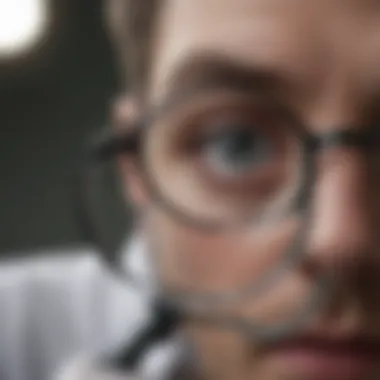Exploring the Essential Functions of Magnifying Glasses in Labs


Intro
Magnifying glasses serve as an often underestimated but fundamentally important tool in laboratory settings. Their capability to enlarge objects allows researchers and students to examine intricate details that would otherwise be invisible to the naked eye. Beyond their basic function, these instruments play a multifaceted role across different scientific disciplines. From biology, where they aid in the observation of cellular structures, to geology, assisting in the inspection of mineral samples, magnifying glasses offer substantial advantages. This article aims to dissect their historical development, various applications, and their significance in enhancing research accuracy.
Key Concepts
Definition of Primary Terms
A magnifying glass, also known as a hand lens, is an optical device designed to produce a magnified view of an object. Composed typically of a convex lens, it focuses light to create an enlarged image. The magnification power varies based on lens curvature and diameter, where a higher curvature results in greater magnification.
Related Concepts and Theories
Magnifying glasses connect strongly with the principles of optics. Optical power relies on refraction, where light bends as it passes through different materials. This fundamental understanding supports the use of various lenses in scientific methodologies, extending from simple hand lenses to complex microscopes.
In addition, magnifying glasses underline the significance of observational skills in scientific inquiry. Observation forms the basis for all scientific theories and hypotheses. By allowing detailed examination, these tools facilitate the gathering of accurate data, empowering researchers to draw more precise conclusions.
"Observation is the foundation of knowledge; without it, there can be no scientific advancement."
Future Directions
Gaps Identified in Current Research
Despite the clear utility of magnifying glasses, there remains a lack of comprehensive studies focused on their efficacy in various settings. Current literature often overlooks the comparative analysis between magnifying glasses and other optical devices, such as microscopes or digital imaging tools. Understanding when and why to choose each instrument can enhance educational outcomes and research productivity.
Suggestions for Further Studies
Future research should consider the following areas:
- User-friendly designs: Developing magnifying glasses that provide ease of use for extended periods.
- Educational impact: Analyzing how these tools influence learning in STEM fields.
- Comparative studies: Evaluating the efficiency of magnifying glasses versus advanced optical equipment in practical research contexts.
By addressing these gaps, the scientific community can deepen its appreciation for magnifying glasses as vital instruments that can enhance laboratory practice.
Prolusion to Magnifying Glasses
Magnifying glasses serve a crucial role in laboratory settings, providing enhanced visibility of small objects and detail. Their importance extends across many scientific fields, influencing observational accuracy and facilitating research methodology. These tools are simple yet incredibly effective. They enable researchers to identify minute details that might otherwise go unnoticed, thus impacting the quality of analysis and results.
Definition and Basic Principles
A magnifying glass is an optical device that uses a lens to produce a magnified image of an object. The primary principle behind it is the bending of light rays through a convex lens, which makes objects appear larger than they are. This basic function allows users to examine samples with clarity, improving the accuracy of observations in laboratory analysis. The size and curvature of the lens determine the degree of magnification, often referred to as the magnification power.
Historical Overview
The history of magnifying glasses traces back to ancient times. The first lenses were made of natural materials such as quartz or crystal. Over time, with advancements in optics, glass became the primary substance for lens creation. The invention of the microscope in the 17th century marked a significant leap forward, building on the principles of the magnifying glass. The development of these tools has paralleled improvements in glassmaking technology and understanding of optics.
Types of Magnifying Glasses
Magnifying glasses come in various types, tailored to meet specific needs in laboratory settings.
Convex Lenses
Convex lenses are the most commonly used type in magnifying glasses. They curve outward, causing light rays to converge, thus enlarging the image of the object being viewed. Their simplicity and effectiveness make them a beneficial choice for detailed observation in laboratories. By offering high-quality magnification, convex lenses help researchers see intricate details, such as cellular structures in biological specimens.
Optical Glass vs. Plastic
When it comes to lens material, researchers often choose between optical glass and plastic. Optical glass is known for its superior clarity and durability, providing precise magnification without introducing significant distortion. On the other hand, plastic lenses offer lightweight alternatives and can be manufactured more cheaply. However, plastic may scratch easier and may not provide the same level of optical quality as glass. Understanding the different characteristics helps in selecting the best option for specific laboratory tasks.


Fixed vs. Adjustable Magnification
Magnifying glasses also differ in terms of magnification settings. Fixed magnification lenses provide a consistent magnification level, ideal for repetitive tasks. In contrast, adjustable magnification allows users to alter the level of magnification based on specific needs. This flexibility can be particularly useful in research where the observation of various details is required at different scales. Each type has its advantages and disadvantages, which should be carefully weighed when choosing a magnifying glass for laboratory use.
Scientific Applications of Magnifying Glasses
Magnifying glasses are integral in multiple scientific domains. They provide precision in observation and analysis. By enlarging minute details, they greatly enhance research methodologies. Their use is not limited to one field; rather, they span across disciplines including biology, material science, and forensic science. Understanding their applications helps highlight their significance and utility in various laboratory settings.
In Biological Research
Microscopic Study of Cells
The microscopic study of cells is one core area where magnifying glasses make an impactful contribution. They allow scientists to observe cellular structures that would otherwise remain invisible to the naked eye. This capability is crucial for advancing our understanding of biological processes. The key characteristic here is magnification. High-quality lenses can magnify cell structures up to several hundred times, providing clarity.
One unique feature of using magnifying glasses in this context is the practicality of on-the-spot examinations, especially in field studies. This characteristic makes them beneficial, as researchers can analyze specimens without bulky microscope setups. However, their limitation lies in resolution; while they offer decent magnification, they cannot replace high-resolution microscopes for intricate cellular detail.
Observation of Specimens
Additionally, magnifying glasses enable effective observation of specimens such as plants and insects. This application extends across various scientific inquiries, including ecology and entomology. The strength of magnifying glasses in this setting is their ability to expose intricate features like textures and tiny details, which are essential for accurate species identification.
One advantage of this approach is its convenience. Researchers can easily transport these tools to locations that may not have immediate access to more advanced technology. However, like in cell studies, there are trade-offs. They might not provide the same level of data that advanced imaging technology offers. Still, for many preliminary surveys, they remain indispensable due to their operational simplicity.
In Material Science
Analyzing Surface Texture
In material science, analyzing surface texture is vital for understanding material properties and performance. Magnifying glasses facilitate this by providing insights into surface roughness, grain structure, and other characteristics that can affect material behavior. A key characteristic is their ability to uncover microstructural features that are decisive for material quality.
Magnifying glasses are not only beneficial; they fill a niche by providing easy access to texture analysis in environments where precision instruments may be impractical. Their unique feature allows for quick assessments necessary for quality control. Limitations include varying degrees of magnification capability, as not all magnifiers are suited for detailed textured analysis at the levels required for research-grade assessments.
Inspecting Material Defects
Additionally, magnifying glasses play a crucial role in inspecting material defects. They enable professionals to identify flaws such as cracks, inclusions, and abnormalities in both raw materials and finished products. Their main strength lies in immediate feedback; quickly detecting a defect can prevent larger issues down the line.
A unique advantage is their portability, allowing for inspections in diverse settings, from manufacturing floors to field studies. However, there is a drawback; complex defects requiring detailed internal analysis still necessitate sophisticated instruments. Despite this, magnifying glasses remain an essential tool in the initial stages of defect analysis.
In Forensic Science
Evidence Examination
In forensic science, magnifying glasses are often the first tool investigators reach for when examining evidence at a crime scene. They allow for meticulous inspection of items such as fingerprints, hair strands, and various trace materials. The key characteristic here is the sharp focus they allow on minute details, crucial for developing leads in investigations.
This method of examination offers the unique feature of a quick visual assessment, which can be pivotal in time-sensitive situations. A drawback, however, is that magnifying glasses cannot capture all the details that more advanced equipment can collect. Still, they are indispensable in preliminary assessments, adding value to the investigative process.
Crime Scene Investigations
Finally, magnifying glasses find a significant role in crime scene investigations. They help in uncovering clues that may otherwise go unnoticed, such as subtle markings or minute evidence left behind by suspects. A notable benefit is their ease of use, providing immediate insight without the need for extensive setup or equipment.
The unique benefit of portability allows investigators to mobilize quickly. However, a potential shortcoming exists when it comes to documenting evidence; magnifying glasses alone do not offer the comprehensive analysis that more specialized forensic tools provide. Nonetheless, their role in supporting crime scene analysis cannot be understated, as they contribute substantially to the investigative process.
Educational Uses of Magnifying Glasses
Magnifying glasses are invaluable tools in educational settings. Their ability to improve visual understanding and engage students in active learning makes them essential for effective teaching. They allow students to observe intricate details that are otherwise invisible to the naked eye. This section examines how magnifying glasses facilitate the learning process through teaching basic principles of optics and enhancing student engagement.
Teaching Basic Principles of Optics
Demonstrating Light Refraction


Light refraction is a key concept in optics that explains how light bends when it passes through different materials. Using magnifying glasses to demonstrate this phenomenon provides a hands-on experience for students. The key characteristic of this method is the tangible observation of light behavior. Students can clearly see how the lens alters the path of light, which reinforces their understanding.
A unique feature of demonstrating light refraction with magnifying glasses is that it reveals the interaction between light waves and the material of the lens itself. This illustrates an important principle that light does not behave uniformly in various mediums. The major advantage is that this direct observation solidifies abstract concepts, making them more accessible for students. However, a potential disadvantage is that if students do not have a basic grasp of light properties, they may not fully appreciate the demonstration.
Hands-On Activities in Classrooms
Hands-on activities are critical for effective learning. Utilizing magnifying glasses in these settings allows students to engage actively with the material. This approach encourages exploration and curiosity. A key characteristic is the interactive nature of these activities, fostering an environment where students can easily ask questions and seek clarification.
A unique aspect of hands-on activities is their ability to cater to various learning styles. Some students may benefit from visual learning, while others may need to manipulate materials directly to understand concepts. The advantages include increased engagement and retention of material, although challenges may arise if students struggle with the technical aspects of the experiments, potentially leading to frustration without proper guidance.
Enhancing Student Engagement
In educational contexts, engaging students is crucial for effective learning. Magnifying glasses can play a significant role in fostering this engagement. They can capture attention and stimulate curiosity, leading to a more immersive educational experience.
Active Learning Strategies
Active learning strategies emphasize full participation from students. Magnifying glasses enhance this by allowing for collaborative exploration of materials in small groups. A key characteristic of this strategy is its focus on student participation, promoting critical thinking and problem-solving skills.
The unique feature of using magnifying glasses in active learning is that they facilitate real-time investigation. Students can examine samples, share observations, and discuss findings, which collectively enhances comprehension. Although active learning can be more challenging to implement compared to traditional lecture formats, the benefits include deeper cognitive engagement and improved retention of subject matter.
Visual Learning Support
Visual learning support is essential for many students, particularly in science education. Magnifying glasses provide visual assistance by making small details prominent. This aspect is beneficial as it can clarify complex information and support understanding.
A unique feature of visual learning support through magnifying glasses is the immediate impact on student understanding. When students can see details up close, they often draw connections between theory and practical examples. The advantage is heightened engagement and comprehension, yet some students may rely too much on visual aids, potentially hindering their ability to synthesize information independently.
"In the classroom, magnifying glasses transform abstract concepts into accessible experiences. By making the small visible, we make learning possible."
Practical Considerations in Laboratory Settings
In any laboratory, magnifying glasses serve as vital tools offering enhanced visibility for various tasks. Understanding practical considerations in their use helps maximize their effectiveness and longevity. This section highlights important aspects including selection criteria for laboratory use and proper maintenance and care, all essential for maintaining functionality and ensuring accurate observation.
Selection Criteria for Laboratory Use
Quality of Lenses
The quality of lenses is a primary factor in the selection of magnifying glasses. High-quality lenses provide clear, distortion-free images, which is essential in scientific investigations. This clarity allows researchers to examine specimens without errors that could arise from inferior optics. Features such as coatings that reduce glare and enhance light transmission are also significant. These enhance observation, making high-quality lenses a preferred choice in laboratory environments.
Magnitude Range
The magnitude range of a magnifying glass determines the level of detail that can be effectively observed. Different tasks may require varying magnification levels. For instance, biological samples might necessitate a high magnification range, while larger, more visible items may need less. Having a versatile magnitude range is beneficial as it caters to a broader range of uses. However, there is a trade-off; higher magnifications can make focus adjustments more challenging, and this needs consideration during selection.
Ergonomics and Usability
Ergonomics and usability ensure that magnifying glasses can be easily handled for extended periods. Instruments designed with comfort in mind reduce strain on the user, facilitating longer observation without fatigue. Features like adjustable positioning and lightweight materials contribute positively to ergonomics. Choosing an ergonomic design is beneficial, particularly in labs where prolonged use is common. Conversely, poorly designed tools can lead to discomfort and inaccurate observations due to user fatigue.
Maintenance and Care
Cleaning Techniques
Proper cleaning techniques are critical to maintain the performance of magnifying glasses. Dust and smudges on lenses can obstruct visibility and lead to incorrect analyses. Using microfiber cloths and non-abrasive cleaners are common recommendations to keep lenses clear. Regular maintenance through proper cleaning ensures longevity of the equipment. Neglecting to clean can result in a gradual decline in optical quality, ultimately affecting research outcomes.
Proper Storage
Storage plays a notable role in preserving the integrity of magnifying glasses. They should be stored in cases that protect them from dust and accidental damage. Proper storage methods can prevent scratches and dirt buildup, which may impair their functionality. Likewise, ensuring that they are not put under excessive pressure will extend their lifespan. This attention to detail in storage can lead to substantial long-term benefits in usability and performance.
Challenges and Limitations


In discussing the role of magnifying glasses in laboratory settings, it is crucial to consider the challenges and limitations that come with their use. Understanding these factors is essential for researchers and educators to effectively integrate magnifying glasses into their work. Issues such as distortion and limitations in resolution can significantly impact the accuracy and reliability of observations.
Issues with Distortion
Distortion in magnifying glasses manifests when the shape, size, or position of the viewed object does not correlate with its actual characteristics. This may occur due to the quality of the lens used, the curvature of the glass, or the distance at which it is held from the object. For scientists, this can lead to misinterpretations and errors and can affect results. Specifically, distortion can present challenges in biological research, such as when observing cellular structures or material properties in forensic science. Understanding the cause of distortions can help researchers choose the right tool.
Factors contributing to lens distortion include:
- Lens Material: Optical glass generally offers better performance than plastic.
- Curvature of the Lens: Variations in curvature can introduce changes in focus and scale.
- Distance from Object: Holding the lens too far or too close can amplify distortion effects.
Limitations in Resolution
The resolution of a magnifying glass refers to the ability to clearly distinguish between adjacent details. However, not all magnifying glasses can provide the desired level of detail for certain scientific applications. Resolution is crucial when examining samples under magnification. In many cases, the resolution is limited by the physical properties of the lens itself as well as the methods of use.
Several key limitations include:
- Magnification Factor: Higher magnification does not always correlate with better resolution. Each lens has a limit beyond which clarity suffers.
- Environmental Factors: Lighting conditions can influence visibility. Insufficient light can obscure important details.
- Experience Level: The skill of the user can greatly affect the outcome. Inexperienced users may overlook crucial features.
Ultimately, researchers must recognize these limitations in order to effectively utilize magnifying glasses without compromising their work. Addressing challenges like distortion and resolution can lead to improved observational accuracy and scientific rigor.
Future Directions and Innovations
The future of magnifying glasses in laboratory settings is poised for significant advancement. Technological innovation and the integration of digital tools are reshaping how researchers and educators utilize these instruments. As demands for precision and versatility grow, magnifying glasses are adapting to meet these requirements. This section examines the emerging trends that are likely to redefine the functionality and application of these essential tools in scientific labs.
Technological Advancements in Magnifying Glasses
Digital Magnifiers
Digital magnifiers represent a remarkable evolution in the functionality of traditional magnifying glasses. Unlike standard lenses, digital magnifiers utilize electronic screens to display magnified images. This advancement allows for greater flexibility in viewing, eliminating the physical limitations of optical devices. A key characteristic of digital magnifiers is their ability to adjust the level of magnification easily, which can range from low to very high levels as needed. Researchers often find this adaptability crucial, especially in fields requiring precise observations.
One unique feature of digital magnifiers is their ability to capture images and save them for future analysis. This feature significantly enhances documentation processes, making it easier to share findings with colleagues and improve collaborative studies. Nevertheless, the drawbacks, such as dependency on battery life and potential technical malfunctions, should not be ignored. Despite these considerations, their benefits in increasing visibility and the ease of use make them a worthwhile option in many research scenarios.
Integration with Computational Tools
Integrating magnifying glasses with computational tools marks another exciting development. This integration allows for a seamless connection between physical observations and digital data analysis. For instance, digital cameras can often be paired with magnifying glasses, enabling the direct transfer of images to software for enhanced examination. This combination facilitates not only an accurate interpretation of findings but also enables advanced image processing to derive deeper insights from the data collected.
A notable advantage of this integration lies in its ability to enhance the efficiency of research. Lab personnel can conduct real-time analyses while observing specimens, significantly reducing the time spent during experiments. However, reliance on technology also introduces challenges, including the need for training to operate these systems effectively. Overall, this integration offers substantial potential for elevating research capabilities in a lab environment.
Potential New Applications
Augmented Reality Features
Augmented reality (AR) features are emerging as a groundbreaking application in the field of magnifying glasses. With AR technology, users can overlay digital information onto the physical world, offering enhanced interactive experiences. This characteristic is particularly beneficial in educational and research contexts, as it allows users to visualize complex data alongside real-time observations.
For example, in a biology lab, a student can use an AR-enabled magnifying glass to see virtual labels and additional information about the specimen being observed. Such an approach fosters an engaging learning environment, enhancing the overall educational experience. However, this technology also comes with limitations, including the need for sophisticated hardware and a learning curve for users unfamiliar with AR. Despite these challenges, the potential for improved learning outcomes and richer experiences makes AR features a compelling area for future exploration.
Cross-Disciplinary Uses
Expanding the applications of magnifying glasses into various disciplines can enhance their utility significantly. For instance, incorporating these tools in disciplines such as art conservation or archaeology can aid in detailed examinations of artifacts. A key characteristic of this cross-disciplinary approach is its ability to merge scientific tools with creative processes, fostering greater collaboration between fields.
One unique aspect of cross-disciplinary use is the ability to bring diverse perspectives to the same instrument. In conservation, for example, researchers may collaborate with artists to understand how materials interact under magnification. This collaborative approach often leads to novel insights and enhances overall project outcomes. Despite potential challenges in communication and methodology standardization, expanding the use of magnifying glasses across disciplines presents myriad opportunities for innovation and advancement in research practices.
Ending
Summary of Key Points
In this analysis, several critical aspects were discussed:
- Definition and Historical Context: We outlined what magnifying glasses are and traced their use back to historical advancements in optics.
- Scientific Applications: Their role in biological research, material science, and forensic investigations was highlighted, showcasing their versatility.
- Educational Uses: The article examined how magnifying glasses engage students in hands-on learning while teaching fundamental concepts of optics.
- Practical Considerations: We placed an emphasis on the selection criteria necessary for laboratory use, as well as maintenance practices to prolong their efficacy.
- Challenges: Discussing distortion and resolution limitations aided in understanding their constraints.
- Future Directions: Innovations including digital magnifiers and augmented reality features were looked at, indicating that magnifying glasses will evolve further to meet new demands.
Final Thoughts on the Role of Magnifying Glasses
Overall, magnifying glasses represent a convergence of simplicity and functionality. They are paramount in enhancing research methodologies, serving an educational purpose, and acting as a bridge between traditional techniques and modern technological advancements. As laboratories adapt to future challenges, the role of magnifying glasses will remain crucial in multiple contexts—scientific inquiry, classroom learning, and perhaps even fields we have not yet imagined. Acknowledging this will encourage continued exploration and integration of these instruments into professional practice.



